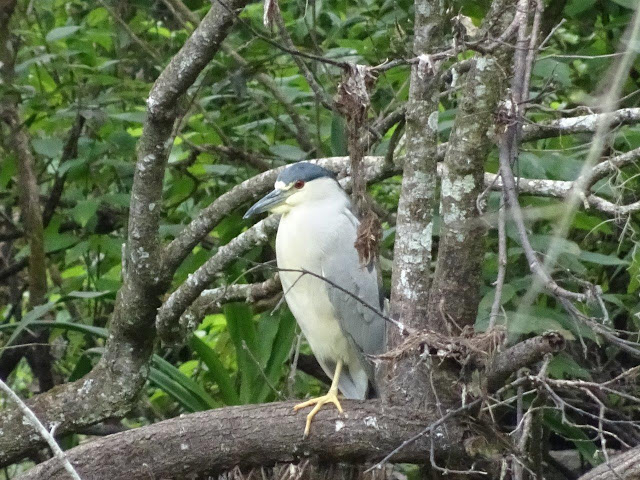You can see the rings around the trees where the water would normally be in this photo.
I started out as part of a tour, but they were noisy and I already knew most of what the tour leader was saying, do I left and went ahead where it was quieter.
Low water does not mean no water. There are always some pools, mostly dug by alligators in the past.
Do you know all those ferns you bought that lost their leaves and looked terrible no matter how many times you watered or sprayed them? That is because they are used to living in a swamp with high humidity, like this one.
This is a nurse log. Basically, that means that when a tree dies and falls, seeds fall on it and take root, so it becomes a habitat that is wet but the plants keep their roots out of the water.
I am reminded here of Robert Frost's, "The woods are lovely, dark and deep."
I have no idea what this plant is, but I thought it looked interesting. It has the thick leaves of a succulent, but what is a succulent doing with its roots in water???? And why is it white?
Turtle is sunning himself.
The bird on the left is an ibis and the one on the right is a great white egret. Check out this video to see the very different techniques they use to feed: https://youtu.be/6NRA3gixepY
This is a grebe. These little diving birds are VERY hard to photograph because they spend so much time underwater and pop up just where you don't expect them! I got lucky with this one.
This is an anhinga. They are diving birds but have no oil glands so they have to dry their wings after each dive.
This little guy puzzled me for a long time. First, he had his head tucked in because he was napping. Then someone said he was a black-crowned night heron, except his "crown" looks blue, not black. So I did some online research and learned that during the breeding season, these birds have something called "powder down." These are tiny specialized feather that never molt, so the tips disintegrate into something like talcum powder that sticks to feathers and make black feathers look slate gray!!! Check it out here and you will see a bird with similar blue-gray feathers: http://www.sibleyguides.com/2011/06/powder-down-and-the-black-crowned-night-heron/
There were a few alligators lazing in the sun.
Can you see the alligator in this photo? He is very sneaky.
This is a yellow-crowned night heron. There is a tiny bit of yellow on his head, but what is really distinguishing is the pattern on his wings.
You can see the beautiful pattern on his wings on this view, as he is turned away from us.
This is a tri-colored heron. It is just a little smaller than the more common great blue heron, but he has a multi-colored beak and white and brown on the front on his neck and down on his chest. You can see more of the white and brown color on the second photo.
This pretty guy is a snowy egret. They are very easy to identify because they are the only white birds with a black beak and black legs, with orange feet. They are smaller than the other herons--about the size of a little blue heron, which I saw but forgot to take a photo of. Imagine a grey-blue heron with a grey beak and grey legs and feet.
Here is another black-crowned night-heron. His feathers look a little darker than the other one. This one also has stretched his neck up. Usually these birds sleep during the day, which is why it is so hard to see them.
Nice profile view!
This is one of my favorite birds--a very pretty green heron! They are a small bird (about the size of a mourning dove, except with a shorter neck.) and are almost always looking down, as this one is. He is standing on the base of a small tree with his beak pointed down, poised to stab a fish if one were to come by. He was only about 20' away in clear view, but I had to point him out to maybe a dozen people who had not noticed him because he was so small and still!
On the way back to the visitor center, I saw this little snake. Not sure what kind he was, but he stayed close to the boardwalk so I got some good photos. Also, saw some raccoons on a tall tree but all my pictures of them were blurry. Raccoons do not pose well.
It was a great day for bird watching, but my right knee was so sore by the time I left that I could barely walk. I will be in Midway next week, but it is a long drive back to the Corkscrew, so I will probably focus my time on Shark Valley and the several other places along the Tamiami Trail in the Big Cypress to see birds and other animals.


























No comments:
Post a Comment